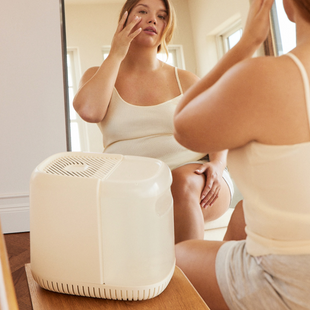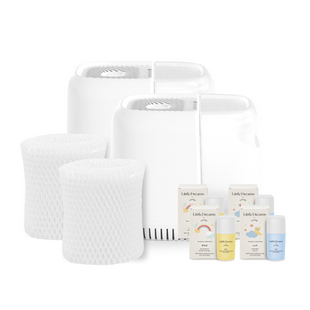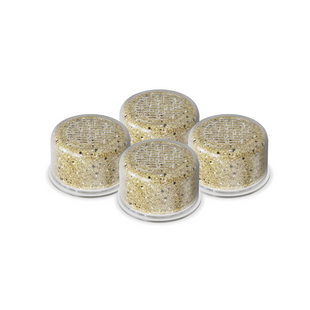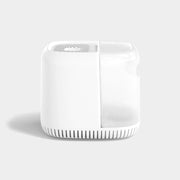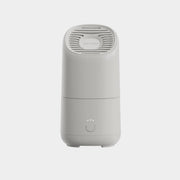This content has been reviewed and updated May 23, 2024.
Many people often misunderstand indoor air quality. Because dust and other pollutants are not visible in the air (most of the time), it's natural to assume that your home's air quality is up to par. Detecting allergens and other contaminants in the air can be difficult, but that doesn't mean your home is in the clear.
There are likely numerous indicators that your home's air quality could be better. For instance, the sniffles you can't seem to shake and your baby's fussiness at night could be symptoms of poor air quality. This article explores common sources of air quality concerns and how to improve air quality in homes.
What Is Air Quality?
First, let's consider air quality on a broader scale. Have you ever seen a cityscape covered in a light or dense haze? That's poor air quality. Air quality is quantified by the concentration of chemical pollutants and solid particles suspended in an area. The denser the haze, the poorer the air quality.
There are numerous ingredients thrown into the poor air quality pot. Human activity is one. We drive cars, which release vehicle exhaust into the air. We like the convenience of electricity, but burning fossil fuels to generate electricity releases nitrogen oxide, carbon dioxide, and particulate matter into the air. These substances hurt the atmosphere and human health — especially for sensitive groups, including children, teenagers, asthmatics and allergy sufferers. Beyond human activity, volcanic eruption and windstorm dust are factors that influence air quality.
Air quality frequently fluctuates daily based on human interference, air movement caused by wind patterns, and air temperature. Think of cold air as a glass ceiling. Exhaust pollutants can't penetrate it, so they stay close to the Earth's surface. Hot air has the opposite effect. It causes pollutants to spread.
Indoor Air Quality
Understanding indoor air quality is vital to maintaining a healthy living environment. It refers to the air quality in buildings, homes, and structures and how it impacts occupants. With awareness of potential pollutants present indoors, you can proactively improve indoor air quality to protect your health.
Of course, polluted outside air can find its way into your home through open windows and exterior doors. However, plenty of air pollutants and allergens are already inside your home. Did you know tobacco smoke lingers in the air after smoking a cigarette, contributing to poor indoor air quality?
Lighting a fire in a wood-burning fireplace is another contributor to air quality. The smoke that seeps into living spaces contains carbon monoxide, particulate matter, and other health-harming pollutants.
Fuel combustion from cooking equipment and central heating contains volatile organic compounds and other toxins. When pollen counts are high, the substance can quickly rush inside on clothes, shoes, and pets. Pet dander also causes air quality concerns.
Dusty furniture, bedding, and flooring are also to blame for poor indoor air quality.
How Is Air Quality Measured?
Various tactics determine the air quality of a specific location. The primary method is the Air Quality Index (AQI). The Environmental Protection Agency created this helpful online tool to show daily outdoor air quality based on the air pollution level. The calculation includes five significant pollutants: particulate matter, sulfur dioxide, carbon monoxide, nitrogen dioxide, and ground-level ozone. The AQI also calculates the health risks associated with exposure to polluted air. The AQI is color-coded. Each color indicates whether breathing in the air will harm your health.
Here is a breakdown of the AQI:
- 0 to 50: Good. Air quality has little to no risk factor.
- 51 to 100: Moderate. Acceptable level of pollution. Air quality may pose a risk for sensitive groups.
- 101 - 150: Unhealthy for sensitive groups. General public should be fine, but sensitive groups may exhibit symptoms.
- 151 - 200: Unhealthy. General public may exhibit symptoms. Sensitive groups may experience severe symptoms.
- 201 - 300: Very unhealthy. Everyone is at risk.
- 301 and Higher: Hazardous. In an emergency warning situation, everyone is likely to be affected.
Knowing outdoor air pollution levels is helpful when navigating outdoor activities or dictating how frequently you open your windows for adequate ventilation. You can also download the Environmental Protection Agency's AirNow app for mobile devices to see the outdoor air quality in your area at a glance.
Modern technology also makes monitoring indoor air quality simple. Portable indoor air quality monitors measure pollutants in the air in a particular space, humidity, and temperature.
High-quality air quality monitors can detect the following particles in your home air: allergens, formaldehyde, ozone, carbon dioxide, radon, and more. When used regularly, an air quality monitor can establish a baseline for your home air quality, which allows you to monitor for harmful home pollution spikes.
4 Ways to Improve Indoor Air Quality
Let’s say you have invested in a top-of-the-line air quality monitoring system and discovered your indoor air quality is concerning. What should you do next? Luckily, there are different DIY tricks you can try to improve air quality in homes.
1. Let Fresh Air In
Open windows and doors to welcome fresh outdoor air and kick out polluted indoor air. Opening your windows for 30 minutes each morning will help improve airflow in your home. Check the AQI before opening windows and exterior doors. Knowing outdoor air pollution levels is important so you don't mistakenly let polluted outside air into your home, increasing indoor air quality issues.
If you live in a big city or a crowded location, opening your windows during traffic lulls is best to avoid adding pollution to your home air. An exhaust fan is a sound investment. It vents gas stove emissions away from your space. Installing a bathroom exhaust fan is also a good idea. The fan directs moisture away from your home, which can prevent mold problems that affect indoor air quality.
2. Prioritize Cleaning
A busy schedule might leave you with little time and energy to keep your home neat and clean—we get it. However, moving cleaning up on your list of priorities will create a calmer, healthier environment for your family.
Dust buildup and pet dander might contribute to poor indoor air quality. Dust hard surfaces, wash bedding and window treatments, and regularly vacuum carpeting and upholstered furniture. Take your shoes off at the door to avoid tracking pollen, mud, and additional allergens, pollutants, and grime into your home. Doing so can help save time on daily or weekly cleaning.
3. Invest in an Air Purifier
An air purifier is responsible for removing contaminants from your indoor air. It does this by drawing air into the device, filtering it to remove pet dander, mold, pollen, and odors from the air. It then releases clean air back into living spaces.
Although an air purifier can improve indoor air quality, a room gets colder as the cleaned air circulates. Cold air can't hold much moisture, so a room might feel drier when you run an air purifier.
4. Invest in a Humidifier
As discussed, drier-feeling air is a drawback to using an air purifier. Running a humidifier and air purifier together solves this concern. A humidifier releases moisture into a room to avoid dryness that irritates the skin, eyes, nose, and throat. The moist air is heavy, which helps airborne allergens and contaminants drop to the ground, aiding indoor air quality.
If you or your baby experience seasonal allergies, breathing in the moist air can help with inflammation and make it easier to unstuff a stuffy nose. The device can also maintain ideal humidity levels between 40% and 60%.
Evaporative and cool mist humidifiers might be the best options for confronting allergies. The Canopy collection brings advanced technology to home hydration. The UV light in our humidifiers inhibits mold, bacteria, and contaminant growth. The Smart Persistent Airflow (SPA)™ technology ensures the device does not turn off until the reservoir is dry, preventing mold growth that affects indoor air quality.
Choose from three mist- and vapor-free options that feature the aforementioned technology. Our pediatrician-recommended Nursery Humidifier can hydrate up to 500 square feet and has an up to 36-hour runtime to keep the baby's room hydrated day or night. Our Bedside Humidifier also delivers 500 square feet of hydration, while our Large Room Humidifier is ideal for hydrating up to 1,000 square feet—great for an open floor plan. Our Portable Humidifier has three fine-mist settings to refresh and hydrate on the go. Pack it in your suitcase and use it in your hotel for a boost of hydration.

